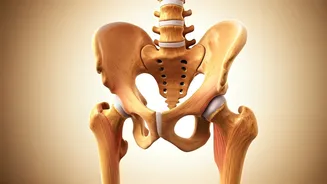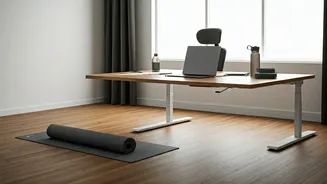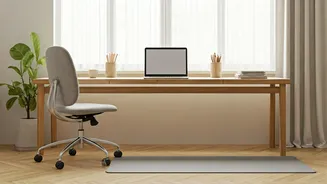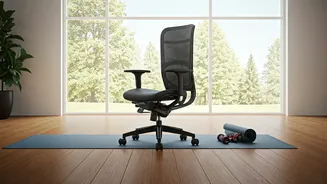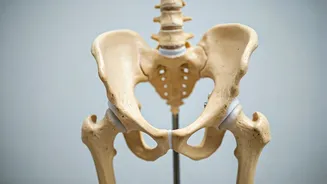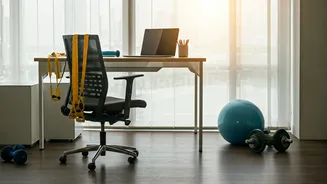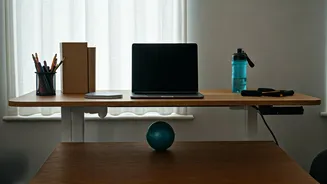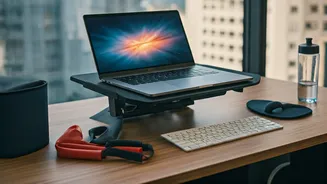Desk Worker's Dilemma
The modern workplace often means long periods of sitting, which, while convenient for many, presents its own set of challenges. Prolonged sitting can lead
to several physical issues. The muscles around the hips, in particular, may become tight and weak, resulting in limited mobility and potential pain. Additionally, a sedentary lifestyle reduces overall activity levels, which may affect metabolism and energy levels. It can also lead to poor posture which may contribute to back discomfort, further emphasizing the need for regular movement throughout the day. The exercises detailed below are designed to counter these issues, providing a practical way to stay active even during a packed workday. Each exercise targets key muscle groups, promoting flexibility and strength to combat the negative effects of prolonged sitting.
Hip Flexor Stretch
This stretch targets the hip flexors, muscles at the front of the hip that tend to tighten from sitting. To perform this exercise, start by kneeling on one knee, ensuring the other leg is bent at a 90-degree angle. Gently lean forward, feeling the stretch in the front of your hip. Maintain an upright posture during the stretch, which intensifies the effect. Hold this position for approximately 30 seconds and repeat on the other side. Regular performance of the hip flexor stretch can alleviate tightness, boosting hip mobility and improving posture. This simple exercise offers a significant return, making it a valuable addition to your desk-based exercise routine. Performing this stretch at regular intervals, can offer significant relief from tightness, promoting better posture and overall well-being.
Glute Bridges for Strength
Glute bridges are a fantastic way to strengthen the glutes, which often become weakened by extended sitting. To do this exercise, lie on your back with knees bent and feet flat on the floor. Lift your hips off the ground, forming a straight line from your knees to your shoulders. Engage your glutes throughout the movement and hold for a few seconds before slowly lowering back down. Repeat this several times. Glute bridges not only fortify your glutes but also help improve hip stability and potentially reduce lower back pain. Regularly incorporating glute bridges into your routine helps counteract the weakening of these important muscles, ensuring better functionality and stability for your body. The exercise offers a simple, yet effective, way to counter the negative impacts of prolonged sitting.
Seated Spinal Twists
Seated spinal twists can enhance spinal mobility and diminish stiffness. While seated upright in your chair, place your hands on the armrests or sides of the chair. Gently twist your torso to one side, holding the position for about 20–30 seconds before repeating on the opposite side. Ensure you're twisting from your torso, not just your shoulders, for the best effect. This movement enhances blood flow and improves flexibility. The seated spinal twist can counteract the rigidity caused by prolonged sitting, improving your range of motion and overall comfort. This exercise is easy to integrate into your workday, providing a quick way to relieve tension and maintain spinal health. Performing regular twists can significantly increase spinal flexibility, helping your body stay limber and at ease throughout the day.
Torso Rotation Exercise
Incorporate torso rotations to improve core stability and mobility. Remain seated with your feet flat on the floor and your back straight. Hold your hands behind your head or at your sides. Slowly twist your upper body to one side, keeping your core engaged. Hold the position briefly before returning to the center and repeating on the other side. This exercise improves flexibility and strengthens the core muscles. The torso rotation offers a straightforward approach to enhance core engagement and boost flexibility, which are often compromised by a sedentary lifestyle. Regularly performing these rotations can help enhance core stability, improve posture and reduce the likelihood of lower back pain. Torso rotations support the body's natural movements, helping to mitigate the detrimental effects of long hours spent sitting.
Shoulder Blade Squeezes
Shoulder blade squeezes counter the forward posture often adopted while working at a desk. Sit upright with your feet flat on the floor and your arms relaxed at your sides. Gently squeeze your shoulder blades together as if trying to pinch something between them, holding for a few seconds before relaxing. Repeat these movements. This exercise helps to reinforce good posture, mitigating the tendency to slump forward. This helps to counteract the effects of extended periods spent hunching over a desk, which is linked to potential neck and back discomfort. Shoulder blade squeezes can also improve upper back strength, which can help to promote a more upright posture, allowing you to breathe more freely and feel more energetic. This exercise offers a simple yet potent method to counteract common postural issues.
Neck Tilts and Rolls
Neck tilts and rolls help release tension in the neck and shoulders. Slowly tilt your head towards your shoulder, holding the stretch briefly before returning to an upright position and repeating on the other side. Follow this with gentle neck rolls, bringing your chin to your chest and then rolling your ear toward your shoulder. These exercises assist in relieving tension, which often accumulates from extended screen time. Neck discomfort is a common complaint among desk workers, and these exercises provide immediate relief. They improve circulation and minimize stiffness. By integrating these movements into your workday, you can prevent or alleviate neck discomfort, maintaining a sense of comfort and enhancing concentration. Regularly performing these neck tilts and rolls is a simple way to combat the negative effects of prolonged sitting.


